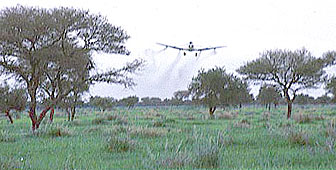Swiss researchers fight cause of African subsistence farmers

A Swiss government-led business delegation touring West Africa has been visiting the International Institute for Tropical Agriculture in Benin, where researchers have made huge strides in controlling tropical plant diseases.
Their greatest successes have been in the battle against two imported enemies of cassava – a shrub with an edible root, which is the main food staple for hundreds of millions of subsistence farmers.
The first calamity struck in the early 1970s and was comparable to the potato blight, which led to the great famine in Ireland more than a century earlier. The cause was the cassava “mealy bug”, which caused the plant to wilt, destroying up to 80 per cent of the crop.
Thirty years ago, researchers at the (IITA) in Benin’s capital, Cotonou, embarked on a search for the natural enemy of the cassava mealy bug. This turned out to be a tiny wasp living in the jungles of South America. When it was released in over 30 African countries, the wasp made a meal of the mealy bug within a decade.
With Africa’s cassava production higher than ever, economists have calculated that every dollar of the $27 million (SFr48.5 million) spent on the project over the decades has earned African small-scale farmers two hundred times that much.
That rate is unparalleled in the history of development projects and earned Hans Herren, the former Swiss director of the IITA, the prestigious world food prize in 1995.
Today Peter Neuenschwander, also a Swiss and Herren’s long-time associate before becoming his successor as director of the IITA branch in Cotonou, prefers to look at the challenges ahead instead of dwelling on past successes.
“It’s perfectly clear that we’ll see many more threats to the cassava like that mealy bug in future,” he warns.
Destructive pests
As is the case with every crop, the cassava plant, which originated in central and south America and was introduced to African coasts by slave traders and missionaries during the 17th century, is at risk from many potentially destructive pests.
Crucially, they are normally held in check by natural enemies in their native habitat, but can spin out of control in far-flung continents.
Modern air and sea transport, the incentive to improve crops by crossing different varieties, as well as the lax enforcement of quarantine regulations have all added to the threat to non-indigenous food crops.
Neuenschwander, 58, who studied zoology in Bern and Berkley before joining the IITA in 1983, oversaw the fight against the cassava green mite, another pest that was inadvertently introduced to Africa from Latin America.
As with the mealy bug, the IITA embarked on a search for a natural enemy of mite, which was destroying up to 40 per cent of the cassava harvests. Eventually, researchers found the predator they had been looking for – another species of mite.
With the cassava green mite pest receding and harvests recovering again, Neuenschwander points to the importance of reliable financing: “For these kinds of projects we need donors who don’t shy away from the long haul.”
Neuenschwander says Switzerland has been the IITA’s “most agreeable donor” in this respect, guaranteeing long-term financing schedules and paying in advance.
The IITA, which has its headquarters in Ibadan, Nigeria, has three divisions. Crop management (which focuses on soil conservation technologies adapted to the African subsistence sector) and crop improvement are based in Ibadan, while Neuenschwander’s division, which deals in plant helped management (PHM) and biological pest control, is in Cotonou.
The IITA receives half of its annual $30 million budget from direct project financing and the other half from the Consultative Group on International Agricultural Research (CGIAR), an umbrella organisation covering 16 research institutions based mainly in developing regions of the world.
Switzerland is among the CGIAR’s top five international donors and, in addition, co-finances some of the IITA’s high priority research projects.
Combating locusts
One is the Lubilosa project, a French acronym for “biological control of locusts and grasshoppers” which is aimed at combating locusts, the scourge of the arid Sahel zone south of the Sahara desert.
Metarhizium, a fungus that occurs naturally throughout Africa, is mixed with oil to prevent the fungus’ spores from drying. The mixture is then sprayed over an area where locusts have settled. “The spores eat up the locust from the inside within six days,” Neuenschwander says with glee.
After a decade of research and testing, the IITA licensed the application to a South African firm earlier this year; it is now on commercial sale under the trademark “Green Muscle”.
But Neuenschwander points out that the socio-economic setting of the Lubilosa project is as important as its strictly scientific aspects. “The fungus works wonders but in a complicated way,” he says. “It’s not as if the locusts fall out of the sky dead as they would with toxic pesticides.”
Farmers and their communities needed to get involved and understand the process, otherwise the project would be doomed to fail in the long run. “That’s why we always use a bottom-up approach,” he says.
He says the “low technology” approach of IITA has become increasingly important over the past two decades when Africa’s economies were eroded by economic crises. In West Africa especially, agriculture had “disappeared off the map of agro-chemical multinationals”.
“Except for some cash crops there is simply no money to be made because subsistence farmers don’t have anything to spend”, Neuenschwander says.
With intensive farming methods that depend on fertilisers, hybrid seeds and pesticides at the end of their wits, the time was ripe for methods that are both cheaper and ecologically sustainable.
by Markus Haefliger

In compliance with the JTI standards
More: SWI swissinfo.ch certified by the Journalism Trust Initiative
You can find an overview of ongoing debates with our journalists here . Please join us!
If you want to start a conversation about a topic raised in this article or want to report factual errors, email us at english@swissinfo.ch.